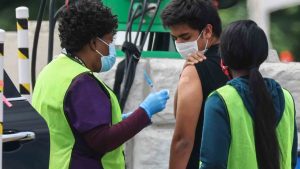
Dallas County crossed a major threshold in its fight to curb the coronavirus pandemic this week, reaching herd immunity on July 4, according to a nonprofit that tracks health data for the county.
At least 80% of the county’s residents have either natural immunity from previously contracting COVID-19 or are vaccinated, officials at the Parkland Center for Clinical Innovation said in a statement Wednesday.
While celebrating the public health goal, officials at the center and elsewhere stressed continued caution as new strains of the virus — especially the delta variant — continue to take hold here and vaccination rates remain stagnant.
“Reaching the 80 percent herd immunity rate is not like flipping a switch, but a continuum in our journey,” said Steve Miff, the center’s CEO. “It is an important accomplishment, which is a credit to the residents and public health leaders who have committed themselves to crush COVID.”
Herd immunity occurs when more than 70% percent of a population has immunity either from vaccinations or past infection, public ealth experts generally say. Herd immunity does not mean the coronavirus is eliminated or that infection stops. However, such a milestone should lead to a dramatic end to an infectious disease.
The center estimates that nearly 49% of the county’s population of 2.6 million residents has natural immunity after recovering from COVID-19. The calculation is based on COVID-19 test results since the beginning of the pandemic. The center assumes that for every positive test recorded in Dallas County, four other adults or five other children also had the virus.
Dallas County has seen a dramatic decrease in new cases and hospitalizations since its peak earlier this year after the winter holidays. But cases and hospitalizations have ticked up and are holding steady, Dr. Philip Huang, the county’s health director, said earlier this week.
“The numbers are still relatively low, but it is concerning,” Huang told county commissioners at a meeting on Tuesday.
The delta variant is predicted to make up about a quarter of all new COVID-19 cases locally, doubling about every two weeks, the center said. And given its more infectious nature, the variant could jeopardize the county’s herd immunity status. Nearly 90% of the county may need immunity to suppress a spike in the delta variant.
Herd immunity is also not uniform across Dallas County: 49 ZIP codes are above the 80% percent threshold but 45 ZIP codes are still below that mark, according to PCCI.
Among the ZIP codes with at least 80% immunity, nine have 100% protection. Those ZIP codes include most of central Dallas, including 75201, 75202, and 75207. Other ZIP codes include North Dallas’ 75251 and southern suburbs of Seagoville’s 75159 and Sunnyvale’s 75182.
The ZIP codes with the least amount of protection, PCCI said, include: Grapevine’s 76051, Lewisville’s 75067 and Grand Prairie’s 75054.
Dr. Jamboor Vishwanatha, director for the HSC Texas Center for Health Disparities in Fort Worth, said wide gaps among ZIP codes continue to leave Dallas County vulnerable.
“Herd immunity is not a uniform distribution,” said Vishwanatha, who had not reviewed PCCI’s data. “While we can take an average for an entire county or city, there is still a lot of work to be done either because of access or hesitancy. We should not go based on an average number. If there are ZIP codes that have not reached 50 percent, we’re all still at risk.”
Only eight Dallas County ZIP codes have less than 50% protection, according to PCCI.
Vishwanatha was not surprised that protection lags in some of Dallas County’s more white and affluent neighborhoods.
While a dearth of access and community outreach has made it challenging to inoculate Black and Latino communities, the vaccine has become a political wedge issue. And new national research suggests young adults are also a key demographic that is not seeking out the vaccine.
“It may not fall exactly on the socioeconomic line, but it’s still playing a role,” Vishwanatha said.
Dallas County’s inoculation rate continues to remain flat, the center’s data show. Less than 40% of the total population is fully vaccinated and less than 50% has received one dose.
“While previous infections and partial vaccinations do provide a level of protection,” said Miff, the center’s CEO, “all evidence suggests that full vaccinations are the most effective way to stay safe against the delta variant.”
 Jago Times "English Edition" Best Online Newspaper
Jago Times "English Edition" Best Online Newspaper